A company’s internal communications can tell you a lot about its culture, organisation and prospects.
Where all team members feel connected and part of a single, unified structure, it suggests a positive, efficient environment. Where they feel detached, it is more likely that deadlines are missed, tensions rise and company culture falls flat.
At a time where just 13% of employees worldwide consider themselves engaged with their employer, it appears that a greater emphasis on improving internal communications is in order.
Our essential guide breaks down the various types of internal communications, best practices for your organisation’s strategy, and how you can build a stronger bond between your workforce and your overarching brand identity.
What is internal communications?
At its core, your internal communications policy is how those in your organisation communicate with each other. The sharinCommon types of internal communicationsg of information for business purposes. The link between your leadership teams and your workforce across the globe.
Unlike your external communications, the other half of your overarching corporate communications, this is not primarily concerned with how your brand is perceived outside of the realms of your company. Instead, the aim of your internal communications strategy should be on fostering a collective culture among your employees through your brand and its core values, from new recruits to seasoned stalwarts.
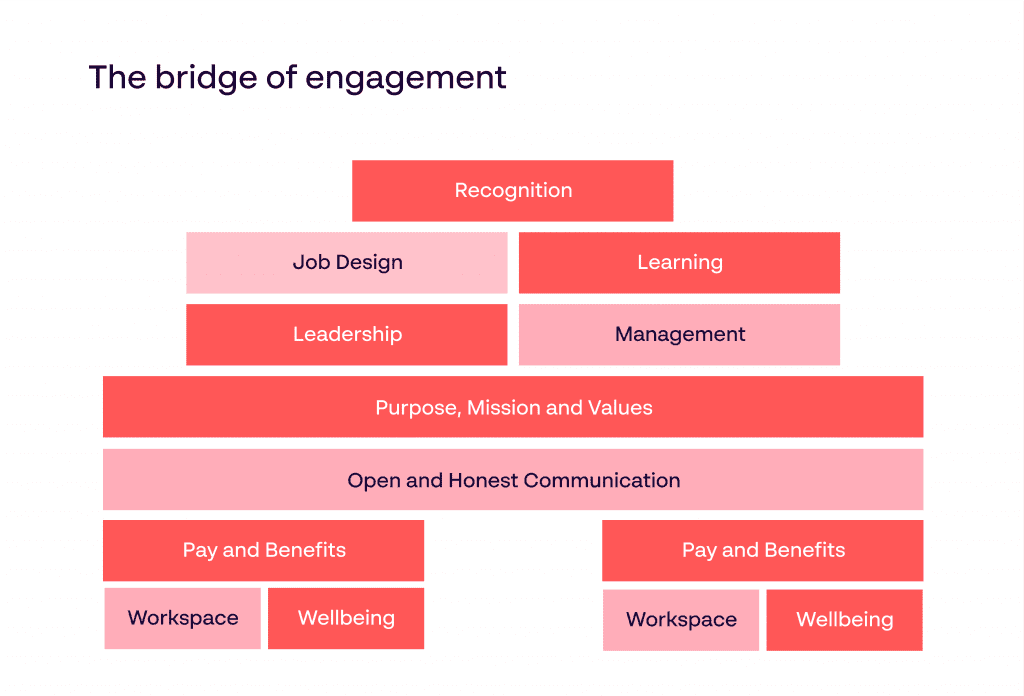
Internal communications is about keeping employees in-sync and in-the-know within your organisation. Not keeping staff connected or conscious about the direction the company is going or what your brand stands for can quickly lead them to become disillusioned and disinterested at work, as they don’t feel engaged with the bigger picture.
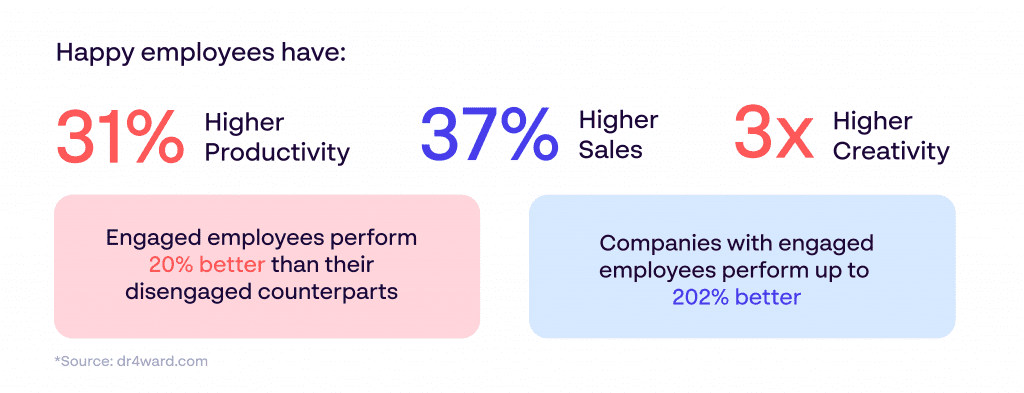
Research conducted in 2015 by Geckoboard illustrates this, with one in four employees leaving their roles as a result of ‘Mushroom Management’, which they defined as a situation where employees are left to perform blindly without any indication of company performance. The priority for your internal business communications should be everyone feels included in what is happening in your organisation.
There are several internal communications approaches that help accomplish this goal, including:
Top-down communications
- the distribution of information from your upper management through to employees down the chain, typically informing staff of company plans, direction and brand values
Change communications
- internal comms that inform employees of any notable changes your organisation is undergoing, such as a new office opening or the emergence of a new policy the company has to adhere to
Information communications
- how your company equips your employees to perform their duties in the most effective way, whether that’s through a company handbook, training tools or peer-to-peer discussions
Crisis communication
- alerting your teams to any problem or difficulty affecting the organisation, be it dangerous weather affecting travel into work to product recalls and cybersecurity attacks
Two-way communications
- often referred to as ‘bottom-up’ comms, this is where your organisation taps into the knowledge, insight and ideas of your employees to discuss potential improvements and get a handle on company culture
Peer-to-peer communications
internal comms where workforces, often spread worldwide, connect and collaborate with each other for a specific project or to lend support, often achieved through email or social networking platforms
Culture communications
- an often-overlooked facet of internal communications plans, this is where your organisation shares materials relating to company values, shares upcoming social events, highlights people to your CSR initiatives, congratulates good work and more in the pursuit of creating a collective identity
Common types of internal communications
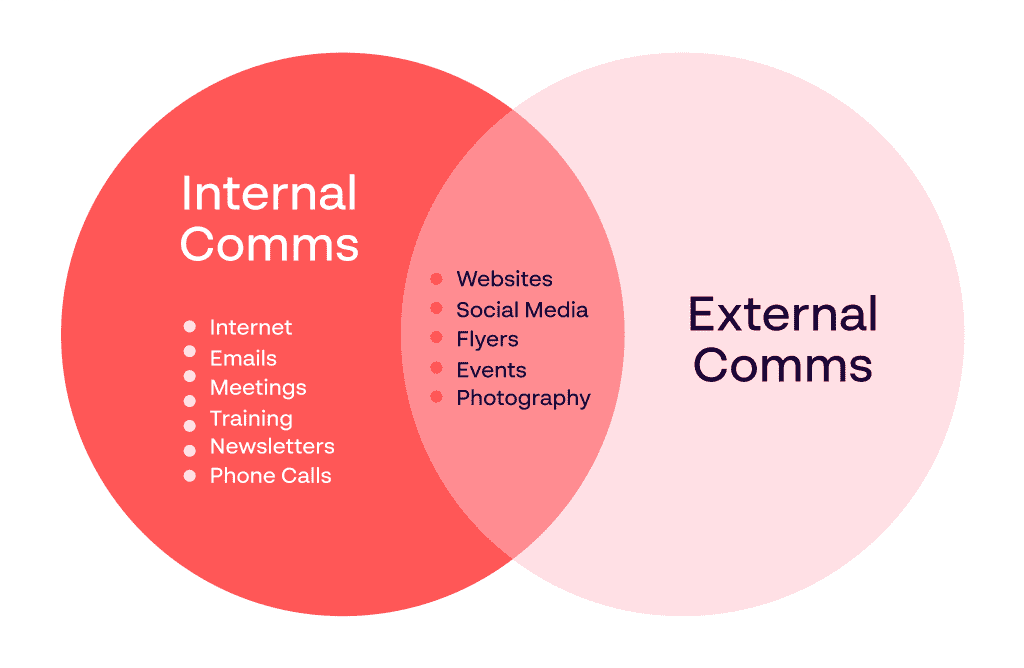
- Employee newsletters or publications
- Social intranets, forums and other online portals
- Team collaboration apps (e.g. Slack, Trello)
- Emails
- Letters
- Company handbooks or guidelines
- Induction processes
- Office displays and decorations
- Team meetings
- Group brainstorming sessions
- Staff evaluations
Why is internal communications important?
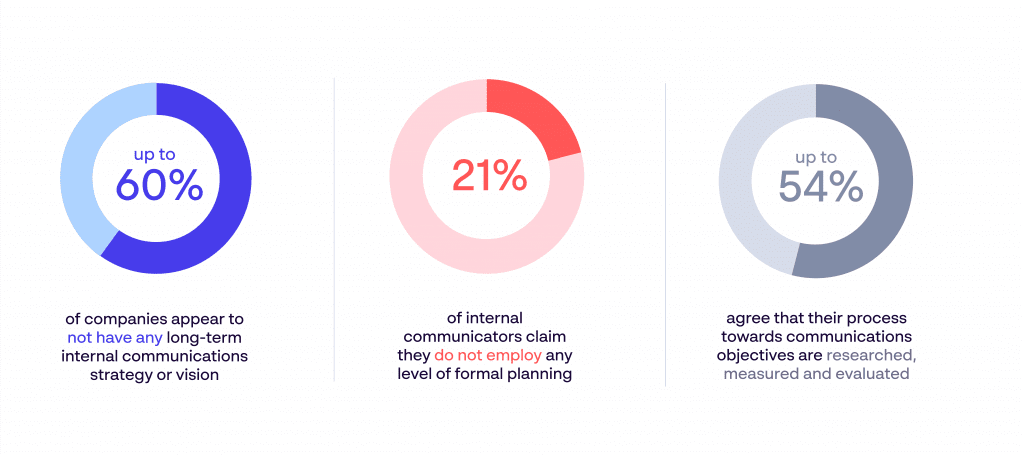
With the purpose of internal communications centred on giving team members a voice and a strong sense of belonging within their organisation, you’d imagine that the overwhelming majority of businesses would position this high in their priorities. But this sadly isn’t the case.
Instead, up to 60% of companies appear to not have any long-term internal communications strategy or vision.
21% of internal communicators claim they do not employ any level of formal planning.
Just 54% agree that their progress towards communications objectives are researched, measured, and evaluated.
There remains an under-appreciation or lack of understanding as to the importance of internal communications on a day-to-day basis, and an assumption that this is something that does not require any concentrated focus.
This couldn’t be further from the truth. Your internal comms team is imperative to enhancing the culture within your organisation and ensuring the long-term retention of your valued employees.
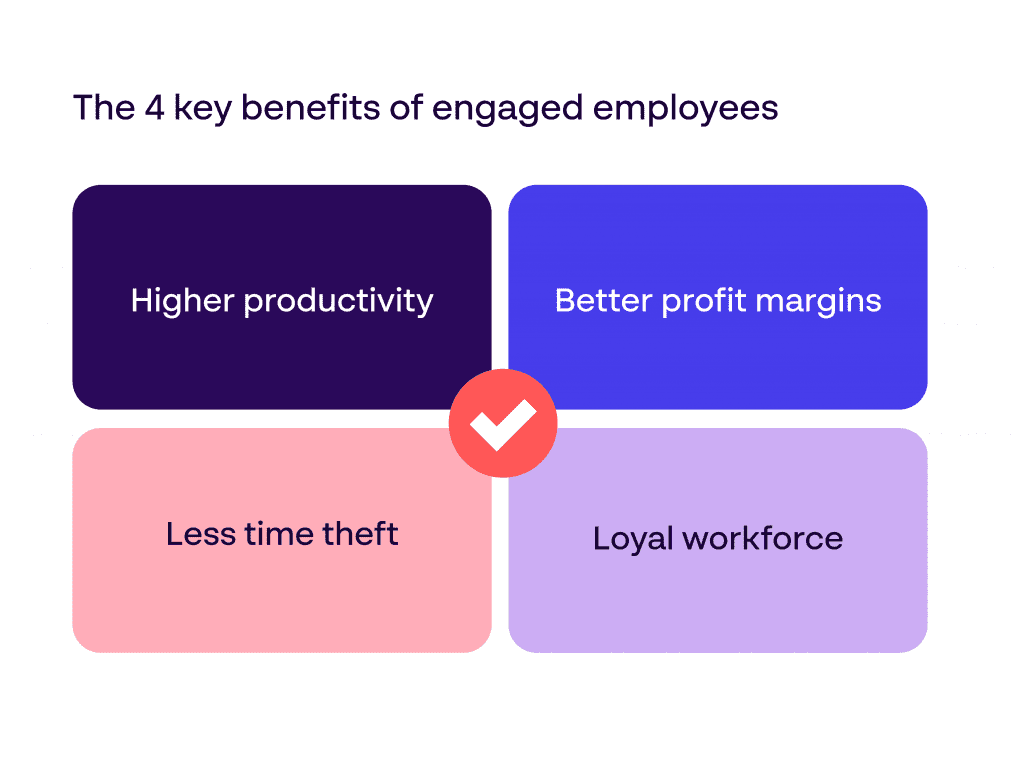
Keep people calm, informed and engaged
Above all else, your internal communications plan is there to keep your workforce unified and up-to-date with the news, events and information impacting your brand. Whether it’s the launch of a new product, a charity event you’d like people to attend, or an internal issue that needs remedying, your communications keep everyone in the loop.
Nobody likes to be kept in the dark. Good internal communications get your teams involved and invested in the big picture for your brand, even if they are spread throughout the globe.
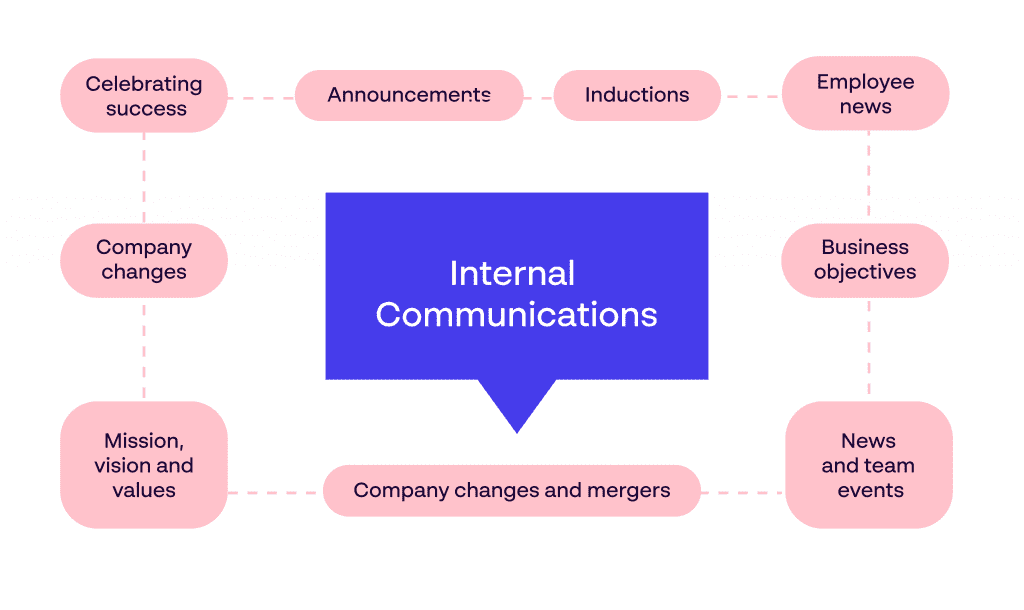
Boost employee productivity
Internal communications tools have the power to increase employee productivity levels by 20-25%, according to research by The McKinsey Global Institute. When employees feel engaged and connected to the organisation they are working for, they will in turn have a greater emphasis to work hard and pull together to achieve your business objectives.
The best forms of internal communications give your employees a purpose. A drive. A reason to perform for your brand. They are more switched-on and clearer about the direction the company is moving, and an informed, valued employee is a motivated employee.
Establish channels for feedback and discussion
Communication is a two-way street, and an excess of top-down materials could cause strain, or potentially result in employees feeling repressed and undervalued. By managing your internal communications effectively, you can create an environment where your workforce feels empowered to voice any concerns and offer suggestions on company culture and developments.
You may be surprised how much knowledge and insight your global teams can offer when they feel empowered to offer their thoughts. This could not only guide innovations and push your brand toward a brighter future, but giving your team members a voice makes it more likely they will want to stay with your organisation for the long term.
Excite, inspire and empower people
Great news is a great motivator, and it should be shared with all members of your company. It could be congratulating a team member on some excellent customer feedback. Or inspiring them with an effective training session. It could even be that your charity fundraiser got featured in the local paper.
Whatever there is to celebrate, your internal communications strategy helps ensure you celebrate as a unit. People feel more connected and enthused with your brand, and morale is lifted going forward.
Keep your brand message consistent
A major aspect of having a clearly defined internal communications policy is ensuring your messaging remains consistent. Especially where your workforce is spread over countries and continents, maintaining your unique brand voice across these channels can be a real challenge without an organised plan. Your communications should always maintain harmony.
This is the reason why part of our brand management solution is directed to support internal communications teams achieve that all-important consistency, from providing a central location for brand guidelines and handbooks to empowering them to create their own materials for their co-workers at home and further afield.
Limit rumours and increase transparency
Hearsay and rumour can distort the information surrounding your brand. This can come as a result of poor communication, or from a lack of communication full stop. If people aren’t informed of developments, they’ll start filling the blanks with their own interpretations, which could bring down morale, breed unsettled or hostile feelings and create an uncomfortable environment.
By getting a handle on managing your internal comms and fostering a spirit of greater transparency, the rumour mill is slowed and employees replace it with trusted information. For a generation that is increasingly inquisitive and craving details, this is a vital benefit that this plan can offer you.
Be visual and uncomplicated
Words are powerful but too many of them can weaken the impact of your messages. Communicating in a way that people can understand, digest and then reflect on is the key to success.
Internal communications doesn’t mean a 2-hour presentation and a 50-page leave behind full of corporate jargon. It’s getting across the key points in an engaging and simplistic way, because realistically nobody is going to have time to read those lengthy documents with any solid comprehension. If you really do need to give your team a 50-page leave behind, provide them with visuals and summaries.
Who needs to implement best practices in internal communications?
The short answer is everyone. But the internal communications strategy should outline who is responsible for driving each strand forward. At a very basic level, there should be communication from an organisational level, at a managerial level and on an individual level.
Organisational comms
- should focus on internal business communication; anything that’s to do with company-wide changes, growth, recognition of long-serving employees or bigger picture initiatives.
Managerial communications
- hinge on being able to create relationships with employees that encourage two-way conversation and feedback. It’s not just another layer for top-down directive or announcements. A manager’s role is as much about listening as it is making sure their employees are kept informed and engaged
Individual communications
- are as much about communicating problems or issues constructively, as it is in keeping the culture alive in a company. This category could cover everything that’s taken care of by HR, social events, improving working conditions and more.
Every company is different, which means no internal communications plan should look the same. That said, the above points are absolutely pivotal best practices in internal communications.
Creating an internal communications plan
Now that we’ve established the importance your internal communications plan has on keeping your workforce engaged, invested and encouraged, how do you go about structuring this for your organisation? A fully-formed approach means a lot more than just regular email chains and annual performance reviews – it should be a fleshed-out, functioning process that covers all bases.
To help you achieve this, we’ve compiled seven effective tips to consider when developing your internal communications strategy:
Assess your existing tools and approaches
First of all, take an objective look over how you currently communicate with your employees:
- What are your most widely used channels? Do you stick primarily to email or offer a more diverse range of internal comms?
- Which channel or approach is performing most effectively? Could you sacrifice others in order to place more emphasis on this?
- What message are these materials sending to your workforce? Does it encompass the values and emotions you want to invoke?
- Are your internal communications consistent? Do they deviate from piece-to-piece or from country-to-country?
Involve your leadership team throughout
Your internal communications team connects your entire workforce – it cannot operate in a vacuum. It is imperative that your senior management team not only buys into the development of a comprehensive plan of action, but is actively involved in this process.
The direct link between your leadership team and your internal communicators helps ensure that the messages that are sent out correlate with your company’s core values and mission statements. That pursuit of consistency starts at the summit, and needs to inform materials that connect your employees to the messages, visions and personality of your brand.
This should be the beginning of a company-wide collaboration to guarantee your internal communications are meeting the needs of everyone it interacts with, from senior leaders and stakeholders to the far reaches of your workforce.
Identify the personalities of your audience
In the same way your external marketing materials will need to be targeted around your ideal customers, your internal marketing communications have to be positioned based on your employee persona. Take the time to analyse and discover what your workforce wants from your communications:
- What information are they interested in?
- What are their likes and dislikes?
- What channels do they interact with outside of work?
- What cultural values and beliefs do they hold?
- Who is most actively interested in communications?
Develop clear objectives to pursue
What do you want to get out of your internal communications strategy?
It is one of the first questions you will ask yourself, and one of the most challenging to answer. The goals of your internal communications plan will drive the direction you take and set a benchmark to work towards, allowing you to measure performance against these over time.
Objectives will vary from business to business. Maybe you hope to realise better consistency across your global communications? Perhaps your current approach is inefficient, with a heavy reliance on email over more agile, innovative internal communications? Or you potentially are more concerned with driving that deeper connection between your employees worldwide with the values and visions your brand represents.
So take your time settling on the objectives of your strategy, the timeline you’ll be operating within, and remember to think SMART:

Craft your company’s tone of voice
Based on what you’ve learned about the personalities within your team, adjust your organisation’s tone of voice accordingly.
There’s a good chance that this will differ from how your brand communicates its products, services and values to your customers. This tone should be geared toward attracting and welcoming new staff to your ranks, as well as keeping your existing workforce motivated and attached to your brand.
While the nature of your tone of voice will be unique to your business, to reap the full benefits of your internal communications plan, it must:
- Present a totally clear and unambiguous message across your various channels
- Embody the core values your company stands for
- Maintain complete consistency at every touchpoint
- Give the right impression to your audience based on the values they hold close
Determine what channels you will utilise
With internal communications, many companies believe the only way is email. In fact, the breadth of channels that these messages can be delivered is vastly different from just a couple of decades ago. Determining which platforms will best reach your employees will depend on your personas, your goals and your budget considerations.
Examples of good internal communications methods you may wish to consider in your business include:
Intranet forums and chatting tools
- applications like Slack, Trello and other Intranet forums offer a great space for co-workers to communicate and announce important information to many people at once, and can often be branded around your organisation.
Face-to-face meetings
- your members of staff might prefer a more personal form of communication to inform them of how they’re progressing, areas they can improve on and discuss ideas that can benefit the whole company moving forward.
Videos
- highly interactive, easily consumable and accessible for employees, it is no surprise that more businesses are using video for internal communications, whether it’s in the form of helpful tutorials for employees or a way of showcasing your social events and developments across your entire workforce.
Social media
- with 53% of people interested in improving their application of digital channels for this purpose, employing social media for your internal communications can present engaging pieces that demonstrate your organisation’s events, values and celebrations to build a stronger bond with your employees.
Workplace displays
- many brands are benefitting from incorporating internal displays, posters and designs within the workplace to consistently motivate and inspire employees, as well as keep them constantly engaged with your brand messages.
Align your external and internal communications
Finally, while there is no question that the messages, tone and audience of your external communications will differ from your internal communications, there needs to be a level of consistency between the two. If the communications you are sending between your team vary significantly from the content you are disseminating to your outside audiences, it can cause a disconnect among your employees or your customers, and in some cases both.
Particularly on the channels that you utilise for both forms of communications, such as your website, social media and emails, it is important to assess whether both sides are clearly following the values and personality of your brand. If they diverge too significantly, discuss both concurrently to identify where changes can be made on both sides to bring them in line.
How to measure the effectiveness of internal communications
We have established how important internal comms is, but all the time, effort and money you invest is futile if you can’t see how well your strategy has performed. Being able to assess your plan’s success means you can identify areas that you need to continue to develop and improve.
Identify your internal communications goals
Knowing what success looks like is half the battle. If you don’t know what you’re working towards, it’s near on impossible to make any progress. These particular goals should be company-wide, what is the bigger picture vision? And what’s the internal comms team’s role in supporting this?
Determine goals for your communications
You may choose to break this down by broader goals for your team such as increasing employee engagement, as well as having more targeted individual campaign metrics. Knowing how to define success will help you shape your strategy, and when things don’t quite go to plan, you can refine based on what you’ve learnt.
Optimise your campaigns with data
With each digital channel for your internal communications, there will be many ways to measure their effectiveness. This can be broken down by clicks, likes, comments and shares. It’s important to take a baseline snapshot of your channels before you begin tracking your campaigns, that way you will be able to see how far you have come.
Employee advocacy
Your employees could be one of your most effective marketing strands in terms of brand awareness and outreach. On the other hand, employees will also feel valued having their opinions and involvement within the company being championed.
5 ways to measure employee engagement for your internal communications
1. Conduct a survey
Survey monkey allows you to create a free questionnaire where your employees can remain anonymous and not have to worry about being too honest. If they don’t agree with some of the communication messaging or methods, this will give them a platform to openly share their opinions without fear of starting a conflict.
2. Implement ‘desktop notifications’
If you have an intranet system your IT team will be able to introduce something called ‘tickers’ that can display key messages and notifications to selected team members, you can then see how many people clicked on them to see more information or simply dismissed them.
3. Measure email open and click-through rates
If your open rates are low, that suggests either your subject lines aren’t relevant enough or your employees don’t care what it is that’s being said. If it’s the latter it’s important to find out why, which is where the survey could come in useful. If engagement is extremely low you may wish to incentivise the survey completion – though this would mean they waive their right to being anonymous. If employees are opening the emails but not clicking through to complete actions or read further then you may want to consider refreshing your tone of voice or getting feedback from a select few.
4. Verbal responses and feedback
What you don’t want to be doing is communicating more about feedback than you do actually delivering your campaigns. Ensure any responses or feedback is never mandatory, so that people don’t begin to resent the exercise. If they feel strongly enough about it one way or the other, they will participate.
5. Monitor turnover and have insight on exit interviews
Lots of employees leave jobs because they feel alienated or not including in certain communication or developments about the company. If your internal communications plan is solid, it may help contribute to a lower turnover rate. If other factors play a role, then see if you can get a question about internal comms within the exit interview process. If anyone is going to be honest about what they think, it’s when they’re on their way out and have nothing to lose.
What does the future hold for internal communications?
Over the past decade or so, more and more businesses have understood the importance of their internal communications and the scope that this covers. While this is still far from universal, this aspect of most companies’ day-to-day life is now receiving more attention than ever, and it’ll only continue to attract more moving forward.
Long gone are the days where a monthly newsletter passed around the office would suffice. Now, more innovative internal communication ideas and methods are forming with the goal of enhancing brand identity, both among team members and projected to the wider world.
So how will internal communication evolve for the future? Below we’ve picked out some key trends to look out for in 2020 and beyond, as these could play a role in moulding your approach sooner than you expect.
Internal communications teams will cement their seat at an executive level
As employees are increasingly valued for the role they can play in supporting an organisation’s brand identity, the more crucial it will be for internal communication teams to be closely tied to company executives.
In years past, the part played by an internal communications strategy was more rudimentary – to entertain staff and inform them of important announcements. While those are still core components of what internal comms are expected to deliver, today’s more nuanced approach is focused on building a dialogue across team members and creating a collective identity.
And this requires greater buy-in at a boardroom level. The executive team is responsible for setting the brand vision, and working directly with their internal communications team can they be assured that it is executed effectively.
So, if there remains a disconnect in your business between top executives and those responsible for projecting your company-wide communications, you should seek to close this in the coming months and years.
The lines between external and internal communications will blur further
As we’ve alluded to in this guide, the gulf separating external and internal communications is shrinking. In the past, there has been a starker divide – newsletters and surveys for your workforce, blogs, infographics and videos for your customers.
Now, there is a move toward more joined-up thinking. If the messages you are projecting externally to customers, partners and the general public doesn’t coincide with your internal atmosphere, it can cause a disconnect between your team and your brand.
This means they are less likely to champion your brand on their personal channels, or to be retained long-term. Instead, by bringing together your external and internal approaches, you are more motivated to produce communications that satisfy the needs and interests of both.
Of course, this doesn’t mean that everything that goes out externally should also be incorporated into your internal messages, and vice versa. But if for instance your company recently took part in a successful charity initiative or achieved record profits for the year, these can be solid foundations for content delivered to both staff and consumers.
There will a greater emphasis on visual storytelling in internal communications
Connecting with your employees is not an easy task, especially if your workforce is spread worldwide. It becomes infinitely more challenging if the approach you take to share internal news and events doesn’t capture their attention.
Producing internal communications that tells a story and illuminates the impact of the information being shared is infinitely more likely to hit home with team members. As such, it is widely anticipated that storytelling will become a more prized component in these messages than might have been witnessed in the past.
Plus, did you know that employees are 75% more likely to engage with internal communications through video than in text? Driving employee engagement behind your brand should be the primary goal of your internal communications strategy, and anything companies can do to better ensure that should be taken on board.
Using more visual storytelling devices, including videos, infographics and quizzes, will make the messages you aim to project resonate better with employees, and make it more likely that they champion your brand on their various platforms.
Employees will expect internal communications instantly and mobile-first
As workforces worldwide welcome more and more millennials and Generation Z team members, there will be a growing need to make all internal communications mobile-friendly.
These generations have grown up alongside the rapid development of smartphones and tablets. This is how they communicate with friends, family, colleagues and brands – and this trend won’t disappear anytime soon. In fact, as time passes it will no longer be considered a recommendation to take your comms mobile – it will be an expectation.
Introducing helpful communication apps (perhaps even a bespoke one for your own organisation) will be vital to present news, updates and developments in a way that future employees will be accustomed to. If you don’t embrace this trend, your business risks a widening disconnect between your team and your brand in the coming years.
Deeper personalisation and innovation in internal communications
Finally, in a similar way to how marketing is developing ways to provide customers with a unique, personalised experience, there is a growing pressure on internal communications to provide tailored materials that speak to each employee.
While this should not go as far as crafting thousands of unique messages to your global team members whenever there’s an event to share, organisations should look at ways to tailor what content certain employees received so they aren’t overloaded with unnecessary information.
Around 62% of the emails someone receives at work every day are considered unimportant and irrelevant. This not only represents a drain on your employees’ productivity for no good reason, but it damages how connected they feel to your brand if they become accustomed to ignoring company communications, even if they’re relevant to them.
An early investment in internal communication tools can go a long way to streamlining the content your employees receive, so they are kept informed only by the information relevant to them. That way, they are more likely to pay attention when something pops up, and engage with it in the intended manner.
This insight into internal communications best practice is just scratching the surface of what is possible and why they are crucial to the development of any organisation.
Particularly in today’s workplace environment where staff want employers that share the same values as they do and are dedicated to an environment that’s transparent and collaborative, your internal communications policy plays a vital role in bringing everyone together under one unified brand.
For organisations with a worldwide reach, this is an even more pressing matter. Ensuring that the translation of your brand vision is achieved in your internal communications across borders, and that everyone feels a sense of belonging to your organisation regardless of what location they operate in, is a challenge, but not an impossible one.
To discover how you can enable your teams to play an active and valuable role in improving your internal communications into something that helps you realise total brand governance, check out our innovative brand management software.
Table of contents:
- What is internal communications?
- Common types of internal communications
- Why is internal communications important?
- Who needs to implement best practices in internal communications?
- Creating an internal communications plan
- How to measure the effectiveness of internal communications
- Employee advocacy
- What does the future hold for internal communications?
